#Biblioteca Marciana
Explore tagged Tumblr posts
Text
𝐕𝐞𝐧𝐞𝐳𝐢𝐚, 𝐫𝐞𝐬𝐭𝐢𝐭𝐮𝐢𝐭𝐨 𝐚𝐥𝐥𝐚 𝐁𝐢𝐛𝐥𝐢𝐨𝐭𝐞𝐜𝐚 𝐌𝐚𝐫𝐜𝐢𝐚𝐧𝐚 𝐥'𝐢𝐧𝐜𝐮𝐧𝐚𝐛𝐨𝐥𝐨 𝐜𝐨𝐧 𝐥'𝐞𝐩𝐢𝐬𝐭𝐨𝐥𝐚 𝐢𝐧 𝐜𝐮𝐢 𝐂𝐨𝐥𝐨𝐦𝐛𝐨 𝐝𝐞𝐬𝐜𝐫𝐢𝐯𝐞 𝐥𝐚 𝐬𝐜𝐨𝐩𝐞𝐫𝐭𝐚 𝐝𝐚𝐥𝐥'𝐀𝐦𝐞𝐫𝐢𝐜𝐚
#Biblioteca Marciana#Carabinieri TPC#Colombo Americhe#Cristoforo Colombo#incunaboli trafugati#lettera di Colombo#libro raro#patrimonio culturale#restituzione beni culturali#Stephan Plannck#Venezia
0 notes
Text
Dalla scienza al quotidiano: la delusione di Pietro Luigi Garavelli tra ricerca e quotidianità
Il medico e ricercatore riflette sulla difficoltà di portare avanti progetti culturali e scientifici fuori dal contesto accademico
Il medico e ricercatore riflette sulla difficoltà di portare avanti progetti culturali e scientifici fuori dal contesto accademico. Pietro Luigi Garavelli, medico e ricercatore di lungo corso, racconta con amarezza le sfide affrontate nel passaggio dalla dimensione scientifica accademica a quella della quotidianità. Con oltre quarant’anni di attività clinica e didattica, e una carriera coronata…
#Biblioteca Marciana#Blastocistosi#Caravello#collaborazione scientifica#contesto accademico#convegni internazionali#critica sociale#cultura e scienza#difficoltà nei progetti culturali#difficoltà organizzative#disillusione#esperienza accademica#girone infernale#Malattia di Zierdt-Garavelli#medici ricercatori#monetazione antica#monetazione classica#passione per la ricerca#patologie eponime#Pietro Luigi Garavelli#progetti culturali#realtà italiana#ricerca in Italia#ricerca in medicina#Ricerca scientifica#riflessione accademica#rigidità culturale#scienza e cultura.#Storia della medicina#storia della numismatica
0 notes
Text

JIŘÍ GEORG DOKOUPIL: Venetian Bubbles
L’artista Jiří Georg Dokoupil con le sue bolle, icone di effimero, riflette sui temi più profondi della condizione umana
0 notes
Text
For #ManuscriptMonday, here is a pair of hippocampus-style seahorses mingling with the more fishy looking fish ;)

Biblioteca Nazionale Marciana, Gr. IV. 35, f. 18v (Greek Physiologus), 16th c.
#animals in art#european art#fish#fishes#seahorse#seahorses#pair#illuminated manuscript#Manuscript Monday#Physiologus#Biblioteca Nazionale Marciana#hippocampus#hybrid creatures#chimera#miniature painting
86 notes
·
View notes
Text

Oswald Achenbach (German, 1827-1905)
Blick auf die Piazzetta mit der Biblioteca Marciana
180 notes
·
View notes
Photo



Dante and Beatrice from Dante’s Divina Commedia, Manuscript (Cod. It. IX. 276) Biblioteca Nazionale Marciana, made by an Italian miniaturist, c. 1380-1400
69 notes
·
View notes
Text

‘Book Front Cover with Christ Pantokrator. Constantinople, late 10th-early 11th century.
This cover, which long contained a fourteenth-century Venetian evangelary, is one of the many objects that presumably reached Venice during the Fourth Crusade as booty from Constantinople. Originally it covered a Byzantine manuscript, most likely a Gospel Book.’
Biblioteca Nazionale Marciana, Ms. Lat. Cl. 1.100
#beautiful books#book blog#books books books#book cover#books#vintage books#book design#10th century#11th century#treasure binding#byzantine
20 notes
·
View notes
Text
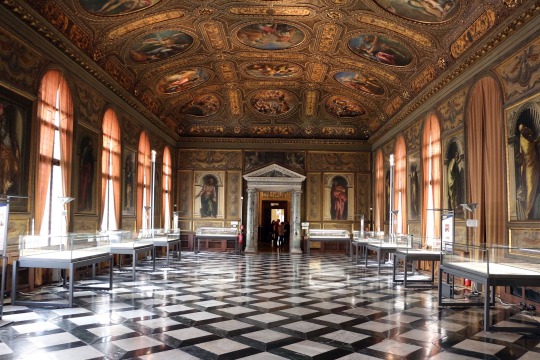
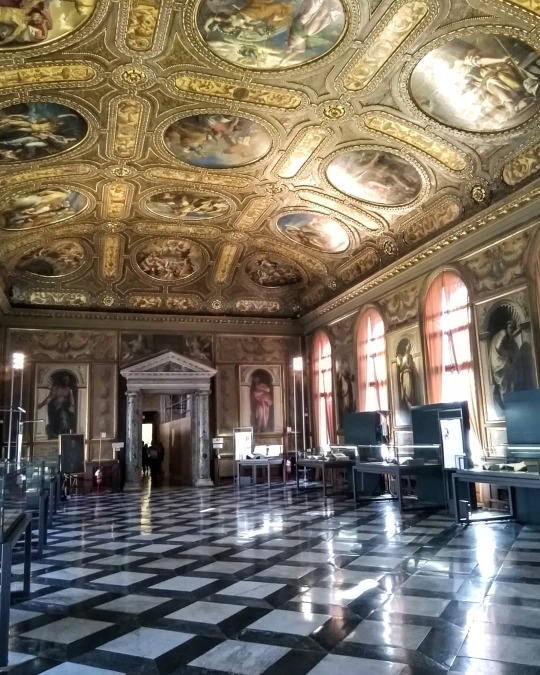
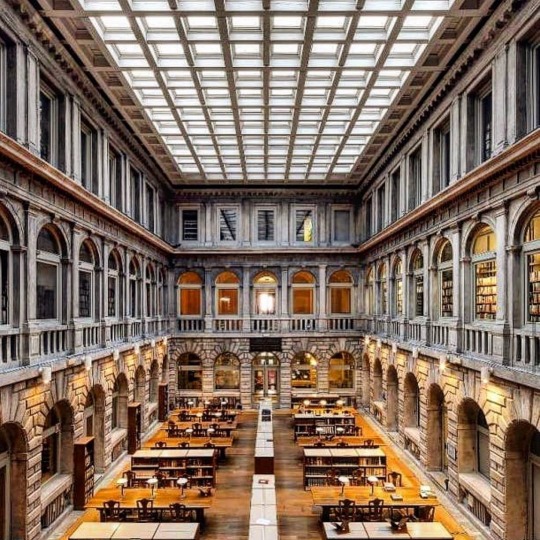
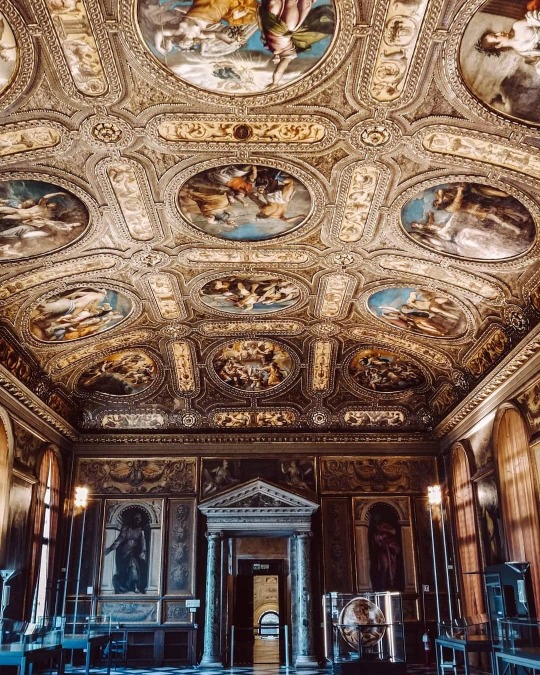



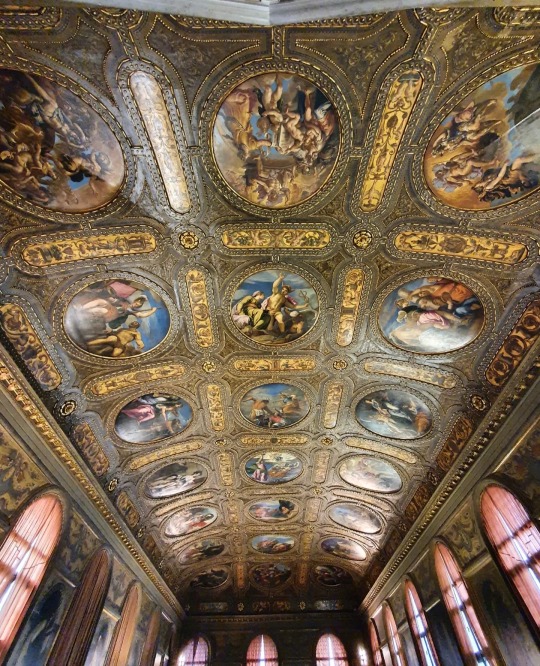

The Biblioteca Nazionale Marciana is located in Piazza San Marco, Venice. Its construction was due to the need to house the private collection of manuscripts, codices and incunabula, donated to the city of Venice by Cardinal Basilio Bessarión in 1468. Its construction began around 1537 under the design of Jacopo Sansovino and was completed by Vincenzo Scamozzi in 1588.
Currently its funds house more than 1million. of printed books, approx. 13,000 manuscripts, 2,883 incunabula and some 24,000 books published between 1500 and 1600. It also houses the unique scores of the operas by Francesco Cavalli (1602-1676), the most important composer of the s. XVII, Italian organist and singer.
Important artists such as Titian, Veronese, Alessandro Vittoria, Tintoretto, etc. also participated in the decoration of the library.
331 notes
·
View notes
Text
27 febbraio. Ho mangiato una frittella alla crema nell'atrio della biblioteca Marciana sotto al pene (o a quello che ne rimane) di una delle due statue giganti, accorgendomi una volta azzannata (la frittella) che l'area era videosorvegliata, non ci si poteva sedere né consumare cibo etc
ma va bene lo stesso, la frittella era deliziosa
7 notes
·
View notes
Text

"Cuando me gradué de la escuela secundaria, no teníamos dinero. No podía ir a la universidad, así que fui a la biblioteca tres días a la semana durante 10 años".
- Ray Bradbury
Raymond Douglas Bradbury (nació en Waukegan, Illinois, EE.UU., el 22 de agosto de 1920-Los Ángeles, California, 5 de junio de 2012. Fue un escritor, guionista, argumentista, poeta, prosista, novelista, cuentista, dramaturgo y escritor de ciencia ficción, fantasía y terror estadounidense.
Su familia se mudó varias veces desde su lugar de origen hasta establecerse, finalmente, en Los Ángeles, California, en 1934. A partir de entonces, Bradbury fue un ávido lector durante toda su juventud y un escritor aficionado. Se graduó de Los Angeles High School en 1938, pero no pudo asistir a la universidad por razones económicas.
Para ganarse la vida, comenzó a vender periódicos de 1938 a 1942. Además, se propuso formarse de manera autodidacta pasando la mayor parte de su tiempo en la biblioteca pública leyendo libros y, en ese periodo, comenzó a escribir sus primeros cuentos. Sus trabajos iniciales los vendió a revistas y, así, a comienzos de 1940, algunos de estos fueron compilados en Dark Carnival en 1947. Finalmente, se estableció en California, donde residió y continuó su producción hasta su fallecimiento.
Bradbury escribió cuentos y novelas de diversos géneros, desde el policial hasta el realista y costumbrista, pero se le conoce como un escritor clásico de la ciencia ficción por Crónicas marcianas (1950), que cuenta sobre los seis primeros viajes a Marte y su posterior colonización. También, trabajó como argumentista y guionista en numerosas películas y series de televisión, entre las que cabe destacar su colaboración con John Huston en la adaptación de Moby Dick para la película homónima que este dirigió en 1956. Además, escribió poemas y ensayos.
Murió el 5 de junio de 2012 a la edad de noventa y un años en Los Ángeles, California, EE.UU. A petición suya, su lápida funeraria, en el Cementerio Westwood Village Memorial Park, lleva el epitafio: «Autor de Fahrenheit 451». Existe un asteroide llamado (9766) Bradbury en su honor.
.
.
Fahrenheit 451
Ray Bradbury
[Fragmento]
"Constituía un placer especial ver las cosas consumidas, ver los objetos ennegrecidos y cambiados. Con la punta de bronce del soplete en sus puños, con aquella gigantesca serpiente escupiendo su petróleo venenoso sobre el mundo, la sangre latía en la cabeza y sus manos eran las de un fantástico director tocando todas las sinfonías del fuego y de las llamas para destruir los guiñapos y ruinas de la Historia. Con su casco simbólico en que aparecía grabado el número 451 bien plantado sobre su impasible cabeza y sus ojos convertidos en una llama anaranjada ante el pensamiento de lo que iba a ocurrir, encendió el deflagrador y la casa quedo rodeada por un fuego devorador que inflamó el cielo del atardecer con colores rojos, amarillos y negros. El hombre avanzó entre un enjambre de luciérnagas. Quería, por encima de todo, como en el antiguo juego, empujar a un malvavisco hacia la hoguera, en tanto que los libros, semejantes a palomas aleteantes, morían en el porche y el jardín de la casa; en tanto que los libros se elevaban convertidos en torbellinos incandescentes y eran aventados por un aire que el incendio ennegrecía.
(...)
Se vio en los ojos de ella, suspendido en dos brillantes gotas de agua, oscuro y diminuto, pero con mucho detalle; las líneas alrededor de su boca, todo en su sitio, como si los ojos de la muchacha fuesen dos milagrosos pedacitos de ámbar violeta que pudiesen capturarle y conservarle intacto. El rostro de la joven, vuelto ahora hacia él, era un frágil cristal de leche con una luz suave y constante en su interior. No era la luz histérica de la electricidad, sino... ¿Qué? Sino la agradable, extraña y parpadeante luz de una vela".
.
2 notes
·
View notes
Text
Ségurant, the Knight of the Dragon (2/4)
Let us continue down our path along the documentary. Here is the German version of it, by the way, if you are interested.
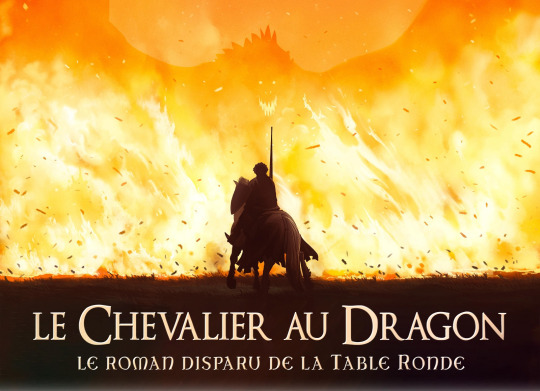
So, last time we left with the sad conclusion that the origins of Ségurant were not from Great-Britain: he appears nowhere in England, Scotland or Wales. If there is nothing in British land, the next move is of course towards the land where Ségurant's tale was first found out, and the second main source when it came to Arthuriana: France.
The documentary reminds us that the Arthurian crossed the seas and arrived in France in the 12th century. It was first written about in France by a man from Normandy named Wace (who was the one who invented the Round Table), and then it was time for Chrétien de Troyes and his famous romans (first romans in French literary history and the beginning of the romanesque genre) – which became best-sellers, translated, imitated, continued and rewritten throughout all of Europe, becoming the “norm” of the literary culture of Europe at the time (in non-Latin language of course). Chrétien de Troyes’ novel became especially popular among the expanding cities and newly formed bourgeoisies of the time, making Lancelot and Perceval true European heroes, and resulting in thousands of Arthurian manuscripts being sent and created everywhere.
There is a brief intervention of Michel Zink explaining what was so specific about Chrétien’s romans: by the time Chrétien wrote his novels, the legend of king Arthur was well-known and famous enough that the author did not feel the need to remind it or expand about it. As in: Chrétien’s novels all happen at the court of king Arthur, or begin at the court of Arthur, but none of them are about Arthur himself. Arthur and his court are just the “background” of his stories – Chrétien’s heroes are the knights of the Round Table, who were until this point basically secondary characters in Arthur’s own story. And all the novels of Chrétien follow the same basic structure of “education novel”: they are all about a young man who goes on a quest or goes on adventures, and in the process discovers his own identity and/or love and/or his destiny. And they all end with the young man being worthy of sitting at the Round Table ; or if they were already at the Round Table, they are even worthier of sitting at it.
But then the documentary completely ditches the French aspect to move to… Italy. As Arioli explains, as he was investigating the origin of the Prophéties de Merlin manuscript in which Segurant’s story was consigned, he checked an inventory of all the Merlin’s Prophecies manuscripts and thus entered in contact with the one that had made it, Nathalie Koble. And talking with her, she led him to a Merlin’s Prophecy manuscript kept in Italy – more precisely in the Biblioteca Marciana of Venice, one of the greatest collections of medieval manuscripts in the world. The documentary goes through a brief reminder of how in the 13th century the Republic of Venice was one of the greatest sea-powers of Europe, and formed the crossroad between the Orient and the Occident through which all the precious goods travelled (spices, silk… but also books) ; and how in the 14th century Petrarch had the project of making a public library in Venice and offered his own collection of books to the city, leading to what would become a century later the Biblioteca Marciana… And so we reach the manuscript Koble showed Arioli. A very humble manuscript of the Prophéties de Merlin – no illumination, no illustration, a small size, not of the best quality ; but that’s all because it was a mass-produced best-seller at the time in Venice. Koble briefly reminds us of the enormous success of the genre of the Merlin Prophecies ; of how French was spoken in Venice because it was the vernacular language of nobility (hence why this manuscript is in French) ; and of who was Merlin and why his prophecies interested so much (being the son of a human virgin and an incubus devil, he had many powers, such as metamorphosis – transforming himself or others – and seeing both the future and the past, aka “existing beyond temporality and memories” as Koble puts it). And finally she points out the very interesting detail that the Merlin Prophecies are always coded, need to be deciphered… But the process is very easy for anyone who is an informed reader.
Indeed, many of the “prophecies” of Merlin are actually coded and metaphorical descriptions of events part of the Arthurian legend. Koble presents us a specific prophecy: “A leopard named Of the Lake will go to the kingdom of Logres and will open his heart to the crowned snake. But he will sleep with a white snake and remove its virginity, while believing he slept with the crowned snake”. For a fan of Arthuriana, it is clear that the “leopard of the lake” is Lancelot du Lac, while the “crowned snake” is Guinevere.
And then, Koble showed Arioli a prophecy contained in this manuscript that apparently was about Ségurant. “Know that the dragon-hunter will be bewitched at the Winchester tournament. A stone will shine on his tent, projecting a great light outside and inside. When he will be king in the Orient, this stone will be placed onto his crown. When he will cross the sea to visit my grave, he will place the stone within the altar of Our-Lady (Notre-Dame). And thus, the dragon of Babylon will seize it.” The prophecy clearly is about Ségurant. Now, the actual author of this manuscript is unknown – as Koble explains, 13th century romanciers who wrote in prose loved inventing false identities for themselves, many times passing off as Merlin himself. The alias of the author of this specific manuscript is “Richard of Ireland”, but Koble’s personal research found out he was actually a man of Venice. Indeed numerous prophecies in the book describes the landscape surrounding Venice or Venice itself ; and there are many references to the political events of Venice at the end of the 13th century.
So, in conclusion: Ségurant was a great heroic figure in the region of Venice at the time. And so Arioli became convinced that Ségurant’s origins were to be found in Northern Italy, and spread from Venice to the rest of Europe.
Our next move is to the Italian Alps – to the Italian Tyrol, and more specifically to Roncolo Castle. Built in the 13th century, it was then bought in 1385 by the Vintler brothers, Nicolas and Francesco/François. The Vintler brothers were part of a bourgeois family that had recently become part of the nobility, and to play onto this, to “legitimate” their nobility and show they had well “adopted” the lifestyle of the nobility, they commissioned a set of medieval frescos, filled with knights and ladies, bestiary animals (fictional or real). To this day, the frescos of Roncolo Castle still form the greatest cycle of Arthurian wall-paintings in the world. And the most interesting part of those paintings, for Arioli’s investigation, is the “Gallery of the Triads”. A gallery where, as the name says, triads are depicted, representing the ideals of knighthood. There is a triad of the “greatest kings” – King Arthur, Charlemagne and Godfrey of Bouillon. There is a triad of the “three greatest knights of the Round Table”: Perceval, Gawain and Yvain (the Knight of the Lion). There is the “three most famous couple of lovers”, with Tristan and Isolde at the center. And finally we have the triad of the “Three most famous heroes”. Only two of them are named – one being Theodoric “with his sword”. And the other… Is “Siegfried, with his crown-depicting shield, as he was described in the Song of the Nibelungen”.
And here’s the new twist in our investigation. Siegfried… Ségurant… Two dragon-killers with similar names. As it is explained in the documentary, the Tyrol was not a closed land, but rather the junction point between Southern Germany and Northern Italy. As a result, Germanic literature was just as popular here as the Arthurian legend – in fact we have a 13th century manuscript written in the Tyrol that contains the Song of the Nibelungs. And so here is Arioli’s new theory: Siegfried crossed the Tyrol, reached Italy, and there became Segurant, the Knight of the Dragon.
The documentary finally gives us the next part of Ségurant’s story, as Arioli first discovered it in the Arsenal manuscript: New character appears! “La fée Morgane” – dear Morgan le Fay, half-sister of King Arthur. “In her castle, the fairy Morgane invoked a devil from Hell. Devil, what is your name? she asked. I am called Lucifer, and I am called Dragon, because I swallow the souls of the sinners. She answered: I needed someone like you for sure!” (I roughly translate here). But here is the idea: the dragon of the legend is not just any mere or random dragon, it is a devil (in fact THE devil himself), invoked by Morgan and obeying her. As the tale continues, we learn that Morgan sent the dragon to cause chaos and panic at the Winchester tournament. “Suddenly, a wall of fire appeared ; behind the flames was a hideous dragon”. And seeing the monster, Ségurant swore that, if he did not set free the kingdom of Logres from the dragon, he would not live one more day. And so he crossed the wall of fire and “forgot everybody, himself as well as the others, he forgot everything, except for the dragon, his sole obsession”. (You might recall this as being a very common trope among French Arthurian roman, like in Lancelot or the Knight of the Cart, where Lancelot every time he sees Guinevere forgets everyone around him, forgets where he is or what he is supposed to do, forgets even his own name, and has his mind only and solely filled with Guinevere. That’s a typical French Arthurian knight thing part of the whole aesthetic of knighthood at the time – but I might explain more about this later).
And yet another twist in the story… Because the roman says that Ségurant could NOT kill the dragon. Why? Because the dragon was “a pure spirit”. And “a spirit, be it good or evil, never dies”. WHAT A TWIST!
We return to the documentary. Crossing the Alps on the search for Siegfried, Arioli stops next by the castle of Drakenburg in Germany – built in 1882 by a wealthy banker, this Neo-Gothic castle is a great homage to the Nibelungenlied – The Song of the Nibelungs. The documentary also reminds us that, at the end of the 19th century, medieval legends were back into fashion thanks to Wagner’s cycle of operas “The Ring of the Nibelungen”. Now, the Song of the Nibelungs is described as “essentially the story of two great families of heroes, the Burgundian heroes and the Xanten heroes. The Song begins when a great hero from the Xanten “side of the world” arrives in the “Burgundian world” – this great hero is Siegfried. And the story of how Siegfried killed a dragon is… a mere mention. An allusion. The Song is not about it, it does not describe it directly, it is another voice that recalls briefly how Siegfried killed a dragon and bathed in its blood. Thus we see that – similarly to what Chrétien did with Arthur – at the time the Song was written, the author and the audience were supposed to know already very well the Siegfried legend. They knew it well enough that it was seen as unnecessary to recall it, a brief mention is enough.
Now, it is easy to admit that Ségurant le Chevalier au Dragon might be a variation of the same myth to which Siegfried the dragon-hunter belongs – similar names, both killed a dragon AND both are also famous for “crossing a wall of fire”. The myth of Siegfried widespread, existing over a large chunk of territory in Europe – not just Germany, but also France, Italy and the Nordic lands. However, while the stories of Siegfried have appeared in the “heart” of Europe around the 1200s, the myth actually pre-existed in Northern Europe for a much older time – in Sweden, in Norway and in Iceland, before Siegfried appeared, there was his Norse ancestor… Sigurd.
And so, this is the next step in the Ségurant investigation: Sigurd, the hero of the Viking sagas.
#arthuriana#arthurian myth#arthurian legend#arthurian literature#ségurant#segurant#le chevalier au dragon#the knight of the dragon#morgan le fay#merlin#siegfried#sigurd#italian literature#french literature#european myths
28 notes
·
View notes
Text

"Seeing an elephant thou wouldst say that a huge mountain-peak or a dread cloud, fraught with storm for hapless mortals, was travelling on the land... Between [its eyes] projects a great nose, thin and crooked, which men call the proboscis... It is said that elephants talk to one another, mumbling with their mouths the speech of men. But not to all is the speech of the beasts audible, but only the men who tame them hear it." ~Oppian, Colluthus, Tryphiodorus. Oppian, Colluthus, and Tryphiodorus. Translated by A. W. Mair. Loeb Classical Library 219. Cambridge, MA: Harvard University Press, 1928 (available online).
This 11th-century Byzantine manuscript depicts an Indian elephant and a man carving an ivory tusk. The text is a tract on hunting known as the Cynegetica.
Sadly, hunting elephants is still a problem. Elephants are still poached for their ivory and hunted as trophies, often by rich outsiders, despite attempts to ban the ivory trade. On the other hand, elephant hunting bans can sometimes be controversial within local communities. Materials: Parchment, ink, and paint Date: 11th century Now Venice, Venice, Biblioteca Nazionale Marciana, MS Gr. Z. 479 (=881), f. 36r
12 notes
·
View notes
Text

ERWIN WURM – Deep
Erwin Wurm, rappresentante di maggior successo internazionale dell’arte contemporanea austriaca, alla Biblioteca Nazionale Marciana di Venezia
0 notes
Text

Venice, a view of the Piazzetta, with the Biblioteca Marciana, Santa Maria della Salute and the Dogana
(1905)
10 notes
·
View notes

